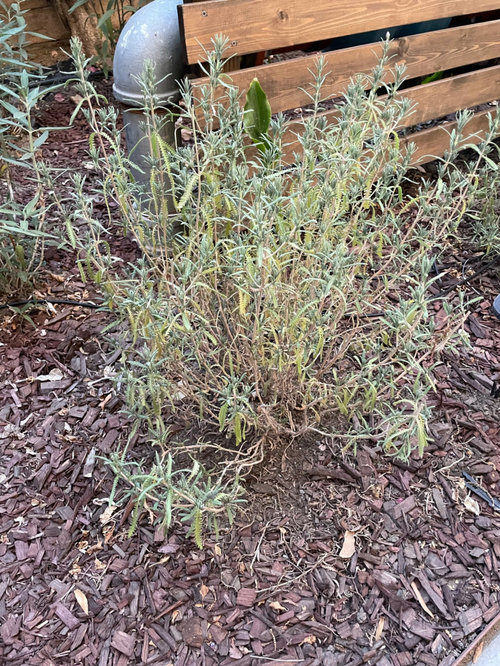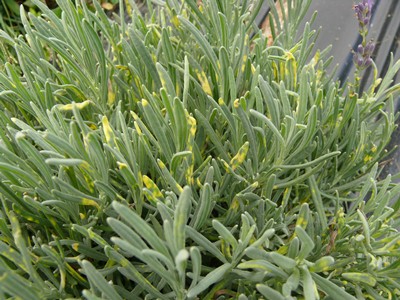Why do lavender plants develop a yellow color?
High nitrogen levels in the soil, excessive watering, or planting lavenders in soil that drains too slowly are the most frequent causes of yellowing lavender leaf.
If the lavender has yellow/brown leaf and appears to be withering or drooping overall, it has either been overwatered or is growing in soil that is sluggish to drain (lavenders are drought resistant).
Too much nitrogen in the soil causes lavender to have yellow, leggy-looking foliage and few blooms.
Continue reading to learn the precise cause of your lavender’s yellowing and the solution.
Table of Contents
Causes of Lavender Turning Yellow: Excessive Nitrogen and Over Fertilizing
All plants need nitrogen as a nutrient, but too much nitrogen in the soil will cause a lavender plant to become lanky, untidy-looking, and have yellowing foliage.
Lavender plants naturally flourish in sandy, nutrient-deficient soils in the Mediterranean region of Europe, where they are indigenous.
You must reproduce these circumstances in order to develop healthy lavender plants that bloom.
If the soil is excessively rich, it needs to be corrected with sand or grit, and mature lavender plants shouldn’t be fertilized. Contrary to popular belief, lavenders are accustomed to low fertility soil and actually prefer these conditions, therefore the more fertile the soil, the more likely you are to see a lavender with yellow foliage and no blooms.
You can balance out nutrient-rich soils by amending with sand and grit as they do not provide many nutrients or nitrogen to the soil. The ideal soil structure, which allows for quick drainage that lavenders need to prevent illnesses like root rot, will also be provided by sand and grit.
Prior to planting lavenders in your yard or pots, it is ideal to supplement the soil with sand or grit; however, you need do so immediately if the lavender leaf is beginning to turn yellow.
Using a fork, dig lavender that has already been planted out of the ground while preserving as many roots as you can. Around 30% sand to 70% soil should be the sand to soil ratio.
(If you have clay soil, I encourage you to read my article on how to get clay soil ready for producing lavender because clay soils require a lot more amending.)
If you make required soil adjustments and stop using superfluous fertilizer, your lavender should recover and bloom the next season if you adhere to the best growing practices.
Yellow Lavender: Over Watering
Perhaps the most frequent error made while caring for lavenders is overwatering. Lavenders need very little, if any, water because they are accustomed to the hard, drought-like conditions of a Mediterranean summer.
Lavenders that have received too much water seem wilted and droop, and their foliage is either yellow or brown. The majority of individuals misinterpret this wilted appearance as underwatering and exacerbate the issue by watering the lavender excessively more.
- In temperate climes, established outdoor lavender plants only require supplementary watering during pronounced summer droughts. Rainfall will provide them with more than enough water.
- Potted lavenders will require extra care because pots do have a tendency to dry out more quickly (see my guide to watering potted lavenders).
- In the spring and summer, lavender plants in arid climates often only require one watering every two weeks.
- Lavender plants kept indoors only require watering every two weeks (see my guide for indoor lavender watering tips).
- In the fall and winter, lavender plants normally do not require any watering at all. If, however, you bring your potted lavender plants inside for the winter, watering them once every 4-6 weeks will be fine (assuming the soil is suitably well draining).
Simply stop watering your lavender for at least three weeks and let the soil and roots to dry out to treat overwatered yellow lavender. However, repeated overwatering can kill some lavender plants, therefore in this situation prevention is preferable to treatment.
Lavenders that have been overwatered and turned yellow are a common issue with poorly draining soils. When attempting to resuscitate a lavender plant with yellow or brown foliage, each of these elements must be taken into consideration.
If you live in a humid, rainy area, I advise growing lavenders in pots since they offer better drainage and the pots may be moved indoors or at the very least to a building’s rain shadow during periods of heavy rain.
See my article on caring for potted lavender for some fantastic advice. All lavender species grow quite well in pots.
Poor Soil Drainage: Yellow/Brown with Drooping Appearance
Sandier soils, as opposed to those with a high organic content, drain quickly and don’t hold onto moisture for very long, making them ideal for lavender cultivation.
Foliage that is yellow or brown is a sign of the illness root rot. The roots of lavender plants cannot handle consistently damp soil, thus they like the soil to dry out between waterings.
You must duplicate the Mediterranean soil conditions where lavender grows successfully. In places like Spain, Italy, and Southern France, the soils where lavender naturally thrives are relatively sandy and occasionally gravelly.
This makes it possible for water to easily drain through the soil, keeping the lavender’s roots healthy and reasonably dry.
Simply adding sand to the planting area will increase the drainage in your garden soil or pots. In most gardens, a good ratio to aim for is 70% soil and around 30% sand. However, you can increase this to 50:50 in soils that are especially slow to drain.
In order to accommodate the roots system of the largest lavender plants when they reach full maturity, the soil should ideally be treated with sand or grit to a depth of around 18 inches.
Then, replant the lavender after tilling or digging the area to add your sand or grit.
As an alternative, you can move your lavender plants into pots or build raised beds to replicate the ideal soil conditions for lavender growth if your yard is particularly low-lying and has naturally moist soil.
The roots of the lavender plant can properly dry out if you add the sand grit, which should prevent the root rot that is making the lavender’s leaf yellow. This will effectively replicate the optimum Mediterranean growing conditions.
It is worthwhile to try to save the lavender plant, however root rot disease can kill lavender that has been in moist soils for too long, necessitating ultimate replacement.
High Humidity
If your lavender is going yellow, high humidity is another another thing to take into account. The roots and foliage of lavender plants want to remain dry (although they can tolerate coastal conditions).
In humid conditions, lavenders will struggle to grow and bloom, but there are a few things you can do to increase their chances:
- Your lavender plants should be placed at least 2-3 feet apart from one another and ideally where there is considerable air movement. The foliage and soil will stay dry with the help of the occasional breeze.
- Lavender needs direct sunlight (at least 6 hours per day). Lavender plants will be healthier and less likely to succumb to disease and discoloration the more sunlight they receive.
- I learned a terrific trick from professional Californian lavender growers: cover the ground with white pebbles or stones. The stark white stones aid in reflecting sunlight back onto the lavender vegetation, which on sunny days creates its own microclimate. This promotes weed control, keeps the lavender plants dry, and increases the amount of oils and blossoms harvested from the plant.
- When you grow lavender in pots, you can choose the spot that receives the most sunlight and, ideally, one that is far from sources of humidity. Placing lavenders on a patio rather then near plenty of foliage will be more favourable for reducing yellowing lavender.
Adding grit or sand to the soil will also help keep the roots of the lavender plants dry, which can be an issue in locations with greater humidity levels. A plant that is healthier and less likely to turn yellow will have drier foliage.
Key Takeaways:
- The most frequent causes of lavender turning yellow include high soil humidity, too much nitrogen in the soil, too much fertilizer, overwatering, and poor soil drainage.
- By amending the soil with sand or grit to create a ratio of at least 30% sand to 70% soil, overwatering and poor soil drainage can be resolved. This replicates the native soil types of the Mediterranean area of lavender. Lavender plants that are established only require watering during dry spells.
- Lavender has evolved to thrive in soil with little fertility. The lavender will turn yellow, become leggy, and produce fewer flowers if soil fertility (especially nitrogen concentration) is too high. By adding sand and grit, which offer the best soil structure but little in the way of nutrients, you can reduce the fertility of the soil and balance out higher fertility soils.
- Don’t give your lavender plants any more fertilizer. Fertilized lavender plants will exhibit the same traits as those grown in high fertility soils: they will turn yellow, become lanky and ugly, and produce fewer blooms.
- Lavenders can turn yellow due to high humidity. Try planting lavender in pots to lessen the impacts of humidity, and place them far apart from other plants (2–3 feet) to allow for better airflow. The lavender’s foliage will remain dry and healthy by reflecting sunlight back onto it through a white reflective stone growing cover.
FAQ
Is my lavender getting too much water?
Stop watering if you’ve been doing it every day. Although young lavender does require significantly more water than usual to establish itself, an excessive amount will eventually kill it. Before watering, always inspect the soil around the plant; if it is completely dry, wet it. If it’s still wet, don’t touch it.
Can lavender get too much rain?
Lavender should not be planted in places in which water sits after a hard storm for longer than a few minutes. During the winter, when drainage is hampered by frost and snow cover, these areas are likely to be saturated for prolonged periods of time.
How do you revive a dying lavender plant?
Lavender Revival Techniques. If root rot is thought to be present, remove the affected roots and replant the lavender in a soil that drains well. Make sure your lavender, whether it is in a pot or not, gets six to eight hours of sun each day. Until the top inch (2.5 cm), water deeply. 13 April 2022
What does an overwatered lavender look like?
Lavender that has been overwatered may have yellowing leaves, first on the lower leaves. Dropping, a decaying smell, and obviously soggy soil are additional signs that a lavender plant needs to be watered less. Lavender that is not receiving enough water will droop, and the soil will feel entirely dry.


